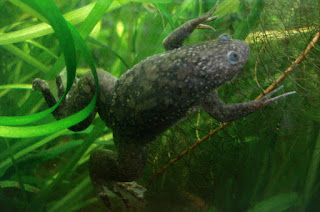
The African clawed frog is a frog species found in eastern and southern Africa. This frog can live in a variety of environments, including stagnant water and fast-flowing streams. African clawed frogs are mostly found in warm rivers during the summer. During the rainy season, they will relocate to the flooded forests. Although African clawed frogs are not listed as endangered, they are extremely sensitive to water pollution. In other parts of the world, the African clawed frog is an invasive species that harms other species in freshwater ecosystems.
The female African clawed frog is larger than the male. Females are typically 4.5 inches long and weigh about 7 ounces. Males are typically 2.5 inches long and 2 ounces in weight.
The African clawed frog’s body is smooth and covered in mucus, which protects its sensitive skin.
The body color can be green, grey, brown, or albino (no pigment) with dark blotches that provide camouflage against predators.
The African clawed frog can change its color to adapt to its surroundings.
On the hind feet of the African clawed frog, three middle fingers have claws. Because they play a role in feeding, the front feet are not webbed (by pushing the food into the mouth).
The lateral line is found on both sides of the body of African clawed frogs. This sensitive organ detects prey beneath the surface of the water. To detect and catch their prey, they also use their sense of smell and sensitive fingers.
The African clawed frog is a carnivore (meat eater) that hunts insects, spiders, small invertebrates, crustaceans, snails, worms, fish, and so on.
After shedding, the African clawed frog eats its own skin.
Because of its small size, the African clawed frog is preyed upon by a plethora of predators. Birds of prey, rodents, cats, dogs, and reptiles are the main predators.
The male African clawed frog lacks vocal cords. Even without them, he can produce a clicking sound to attract females during mating season.
Depending on their desire to mate, females will respond by producing accepting or rejecting calls.
Females can lay between 500 and 2000 eggs per mating. Mating occurs several times per year, and one female produces between 2000 and 8000 eggs per year.
Eggs will hatch after one week. The African clawed frog does not show parental care, and tadpoles are left to fend for themselves. Tadpoles will develop into adult frogs in 6 to 8 weeks.
African clawed frogs are frequently used in research. After injecting pregnant women’s urine into a female African clawed frog, she begins to produce eggs. Their embryos are particularly valuable for science because they are transparent, allowing for close examination of embryonic development.
The African clawed frog can live in the wild for 8 to 15 years and in captivity for up to 30 years.








